What’s the first dish that comes to mind when you think of traditional Ukrainian food? For most people, it’s borscht. It’s a national dish of Ukraine and the most representative of Ukrainian cuisine.
While this beloved red beetroot soup is definitely a must-try in Ukraine, it’s just one of many tasty dishes Traveleaters can look forward to when they visit this large Slavic country in Eastern Europe. Expansive but often overlooked, Ukraine is home to gorgeous architecture, centuries-old cathedrals, rugged coastlines, and a rich agricultural tradition that’s earned Ukraine the nickname, “the bread basket of Europe”.
If you’re visiting Ukraine and wondering what else you should try other than borscht, then you’ll probably want to add these twenty Ukrainian dishes to your list.
UKRAINIAN FOOD QUICK LINKS
If you’re visiting Ukraine and want to learn more about the cuisine, then you may be interested in joining a food tour.
TOURS & OTHER SERVICES
- Food Tours: Food and Wine/Drinking Tours in Ukraine
- eSIM: Ukraine eSIM
Save This on Pinterest!
No time to read this Ukrainian food guide now? Click on the save button and pin it for later!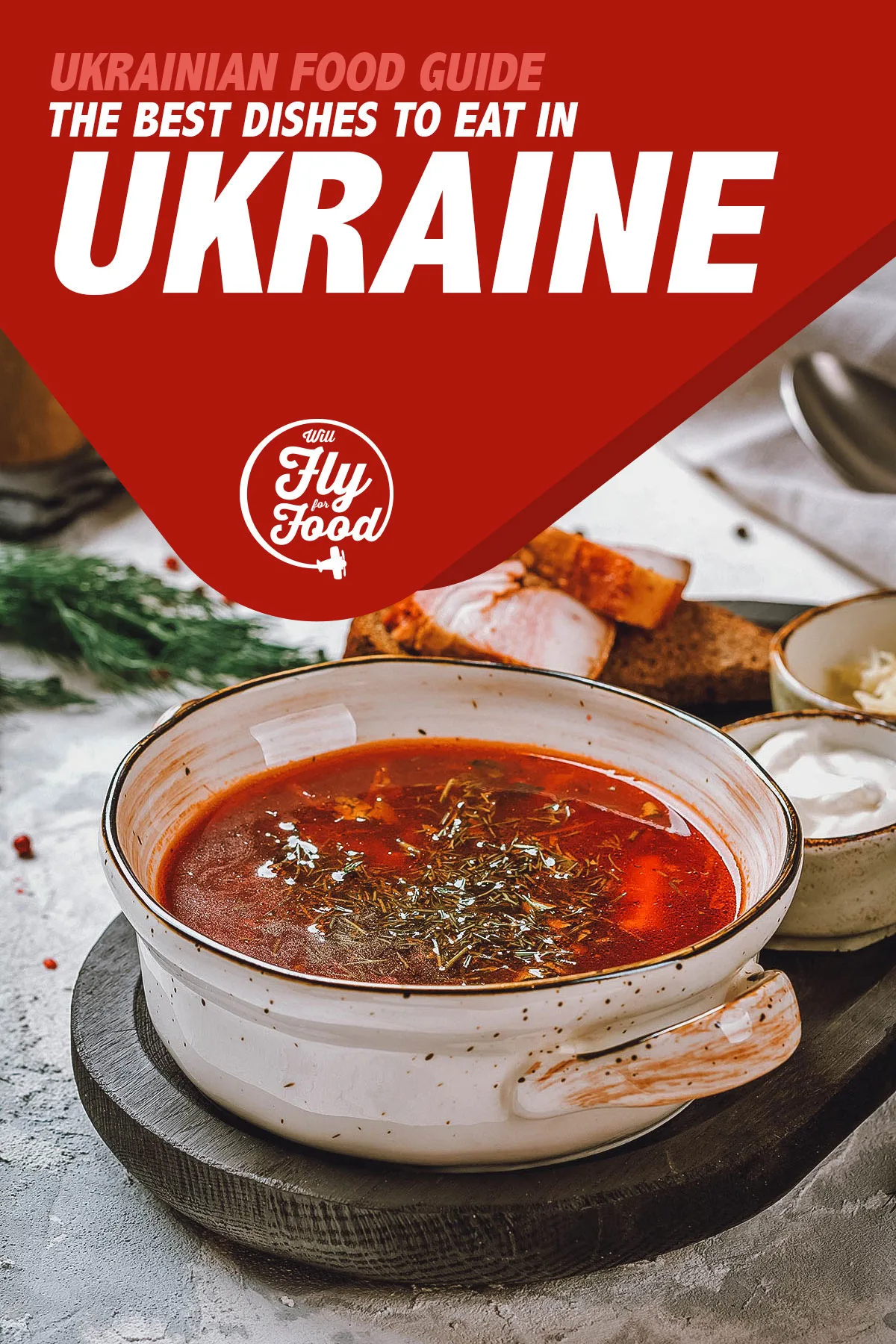
Photo by bbivirys
WHAT IS TRADITIONAL UKRAINIAN FOOD?
Ukraine is often referred to as “the bread basket of Europe”. This is because an estimated 70% of Ukraine’s land area of 603,000 square kilometers (232,820 sq mi) is devoted to agriculture.
Not only does Ukraine have a vast amount of arable land, they also have some of the world’s finest. Nearly 60% of its arable land features a rich dark soil (chornozem) that’s ideally suited for growing a wide range of crops like wheat, barley, sugar beets, corn, sunflower, and soya beans.
Being one of the best places in the world for agriculture, grains and vegetables have long played an important role in Ukrainian cuisine. Breads made from rye or wheat flour are a centerpiece on every Ukrainian dinner table while vegetables like potatoes, carrots, pumpkin, tomatoes, and corn make their way into many traditional Ukrainian recipes.
Beetroot, the primary ingredient in borscht, is the king of all Ukrainian vegetables. In fact, so deep is the people’s love for this red beetroot soup that 44% of Ukrainians polled declared it to be their favorite dish.
THE BEST FOOD IN UKRAINE
This Ukrainian food guide has been organized by category to make it easier to digest. Click on a link to jump to any section of the guide.
STARTERS / SALADS
1. Varenyky
Other than borscht, there’s no better way to start this Ukrainian food guide than with varenyky, the Ukrainian version of the popular Central and Eastern European pierogi. Dumplings are an important part of many cuisines and with this stuffed dumpling being a national dish of Ukraine, the varenik is no exception.
Varenyky are stuffed Ukrainian dumplings filled with a variety of ingredients like potatoes, ground meat, sautéed cabbage, mushrooms, and cheese. They can also be made with dessert fillings like fruit and sweet cheese. The dumplings are typically formed into half-moon shapes before being boiled and served with smetana (sour cream).
Ukrainians love sour cream and always eat it with varenyky. According to this Ukrainian food blogger, they wouldn’t even bother making it if they were out of sour cream. Varenyky are very similar to Polish pierogi but they’re usually smaller and made with a thinner dough.
Varenyky are such an important part of Ukrainian cuisine that a festival is held in Bukovel every year to celebrate this beloved dumpling. To Ukrainians, the varenik isn’t just a national dish, it’s a symbol of their culture.
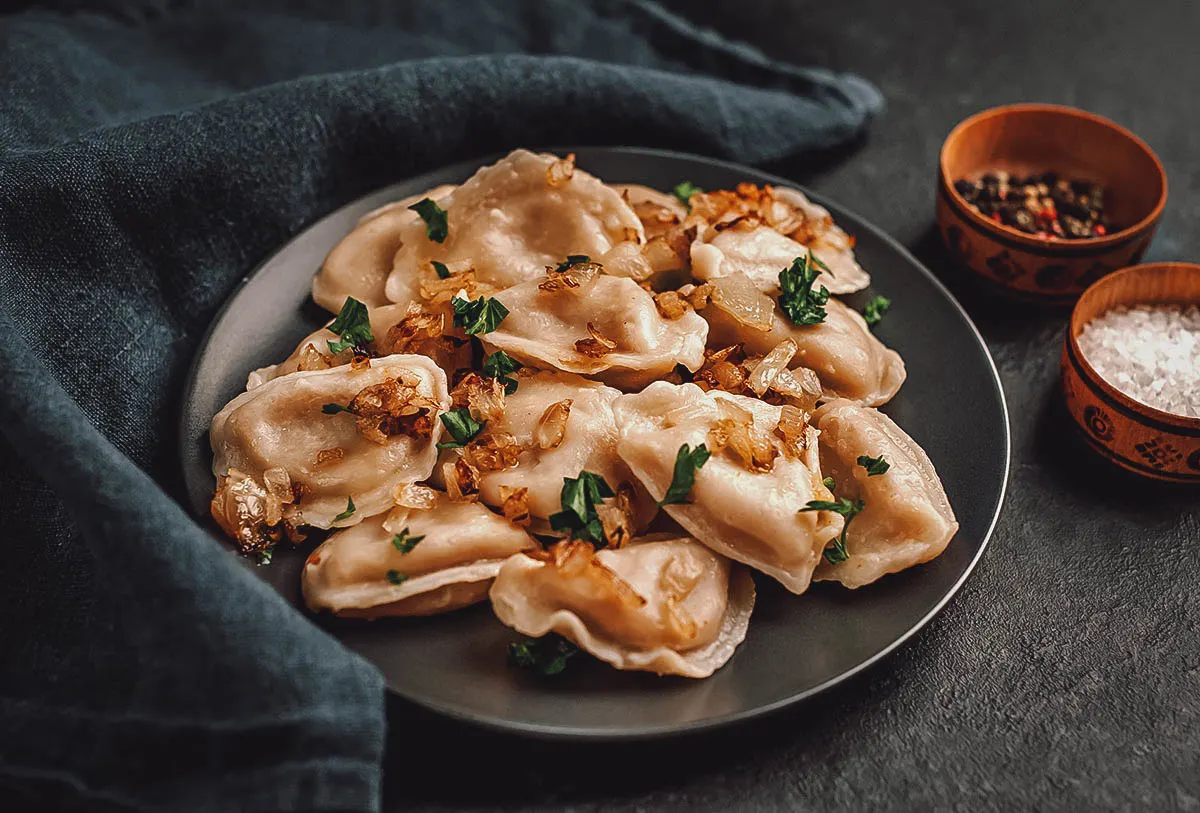
Photo by [email protected]
2. Olivye Salad
Olivye salad is what Ukrainians call Olivier salad, a type of potato salad popular in Russia and post-Soviet states. More commonly known as Russian salad, it’s become popular in the cuisines of many other countries throughout the Balkans, Central Europe, the Mediterranean, Asia, and Latin America.
Recipes for olivye salad vary from region to region but its core ingredients are potatoes, eggs, and mayonnaise. Depending on the cook, the salad can be made with any number of supplemental ingredients like peas, carrots, onions, and pickles. It usually contains some type of meat like bologna, chicken, or ham as well. The ingredients are mixed together with mayonnaise and often served at celebrations, holidays, and family gatherings.
It was interesting to learn that modern versions of olivye salad are quite different from the original recipe. Invented by Chef Lucien Olivier, a Russian chef of Belgian and French descent, the original recipe for the salad’s dressing was believed to contain a version of mayonnaise made with French wine vinegar, mustard, and Provençal olive oil, among other ingredients.
Chef Olivier introduced the salad at his famous Hermitage restaurant in Moscow in the 1860s. It was an instant hit and became the restaurant’s signature dish. The recipe was a well-guarded secret but it contained ingredients that aren’t used in the versions of today like grouse, smoked duck, veal tongue, caviar, and crayfish tails.
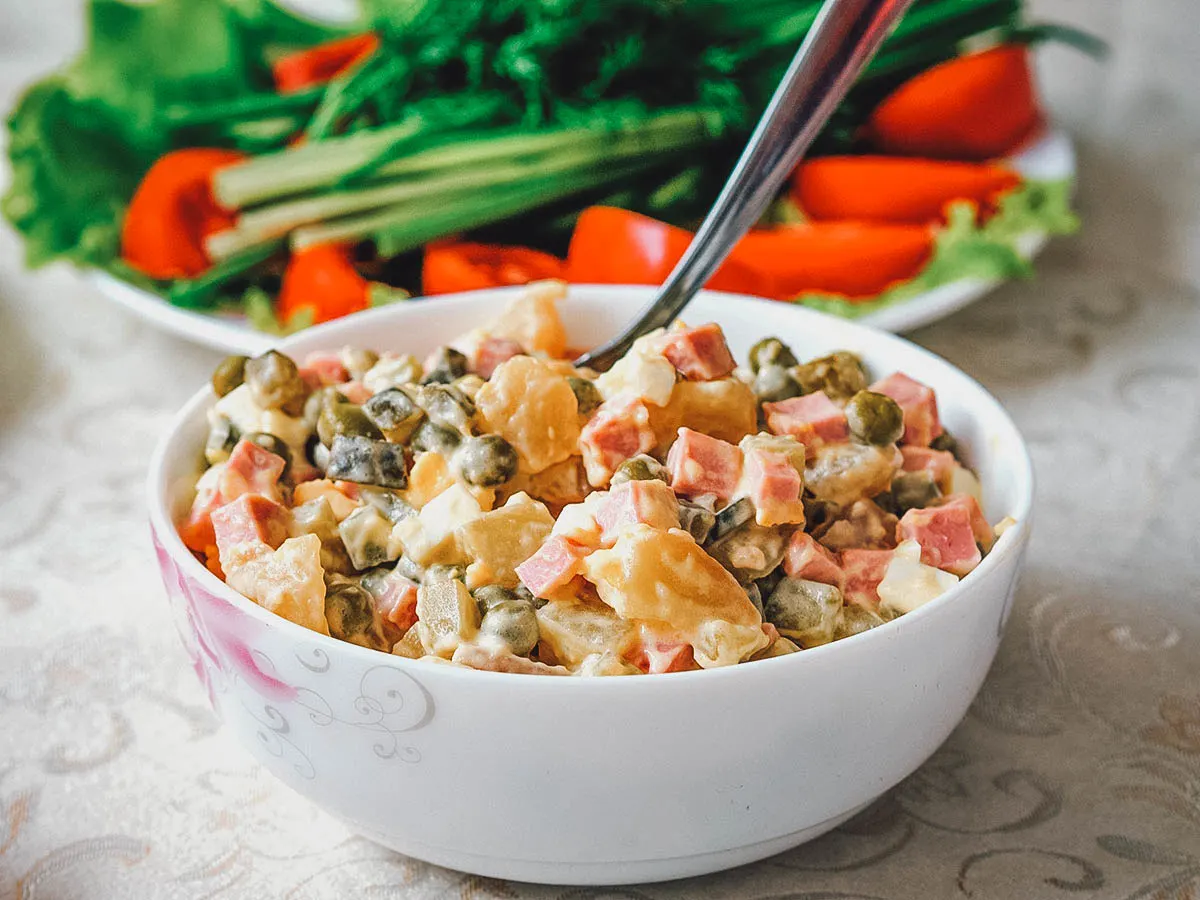
Photo by igorgolovniov
SOUPS / STEWS
3. Borscht
As described, borscht is the most famous dish in Ukrainian cuisine. Like varenyky, it’s a national dish of Ukraine. Known for its distinctive deep red color, it refers to a type of Ukrainian beet soup made with beef, cabbage, and a variety of root vegetables.
Borscht (or borsch, bortsch) is a Slavic dish popular throughout Eastern Europe and Northern Asia. It features prominently in Russian, Polish, and Lithuanian cuisines though it’s generally believed to be Ukrainian in origin. The earliest recorded mention of borscht dates back to the late 16th century, to the diary of a German traveler who encountered the dish during a visit to the Ukrainian capital of Kyiv.
There are as many recipes for borscht as there are Ukrainian cooks, but it’s typically made with beets combined with meat (usually beef or pork), kvas (beet sour), and a variety of sautéed or boiled vegetables like cabbage, carrots, onions, potatoes, and tomatoes. It’s a sweet, tangy, and earthy soup that can vary in thickness and be served hot or cold, usually with a sour cream garnish and dill.
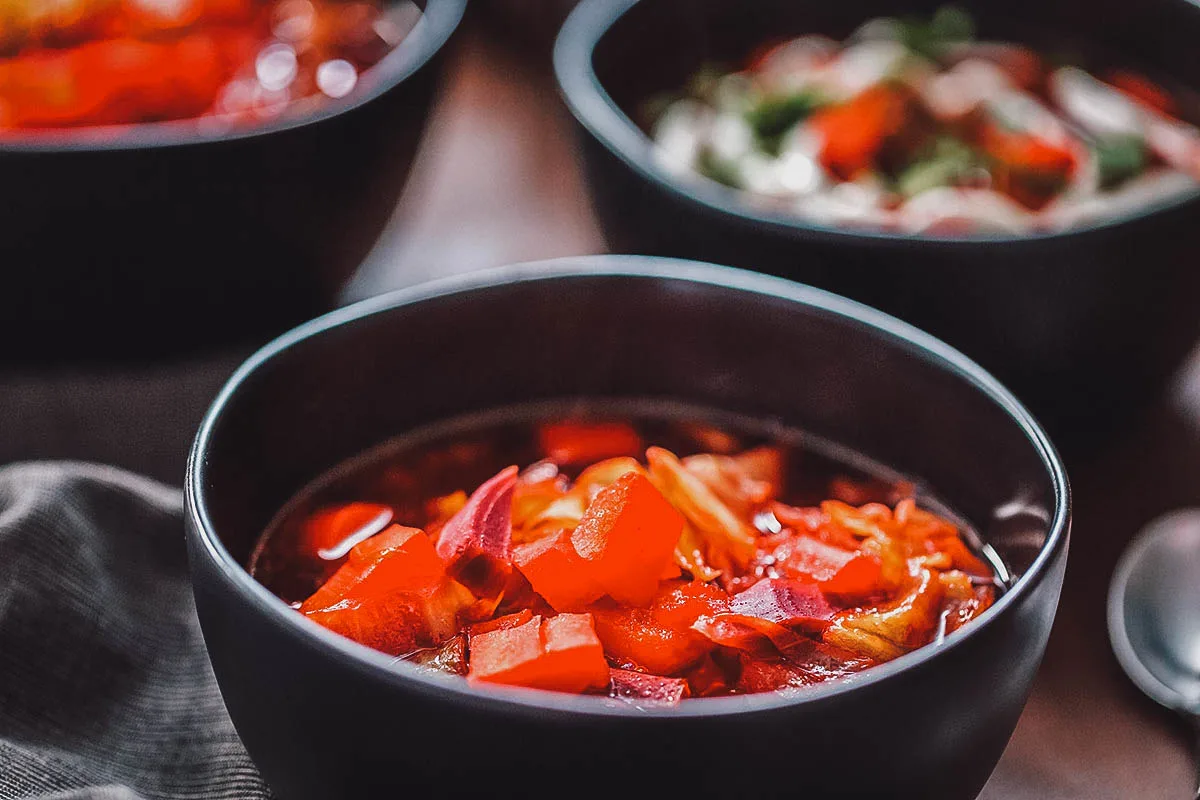
Photo by urban_light
4. Zelenyj Borshch
Zelenyj borshch translates to “green borscht” and refers to a type of sour-tasting Ukrainian soup made from leafy vegetables. Sorrel is most commonly used though it can be made with other vegetables as well like spinach, chard, nettle, and orache.
Even though it isn’t made with beetroot, zelenyj borshch belongs to a family of sour-tasting soups identified as borscht. Other examples include white borscht and cabbage borscht. However, since they aren’t made with any beets, they aren’t considered true borschts.
In Slavic cuisine, an ancient soup made from hogweed spawned an array of tart soups made from a variety of souring agents. Green borscht, white borscht, and the red beet-based borscht were among those soups. However, borscht made with beets became so popular that it ultimately eclipsed all the others in terms of being associated with the term “borscht”.
Like beet-based borscht, zelenyj borshch is based on a meat or vegetable broth and typically served with boiled potatoes and hard-boiled eggs. It’s usually garnished with dill and served with sour cream.
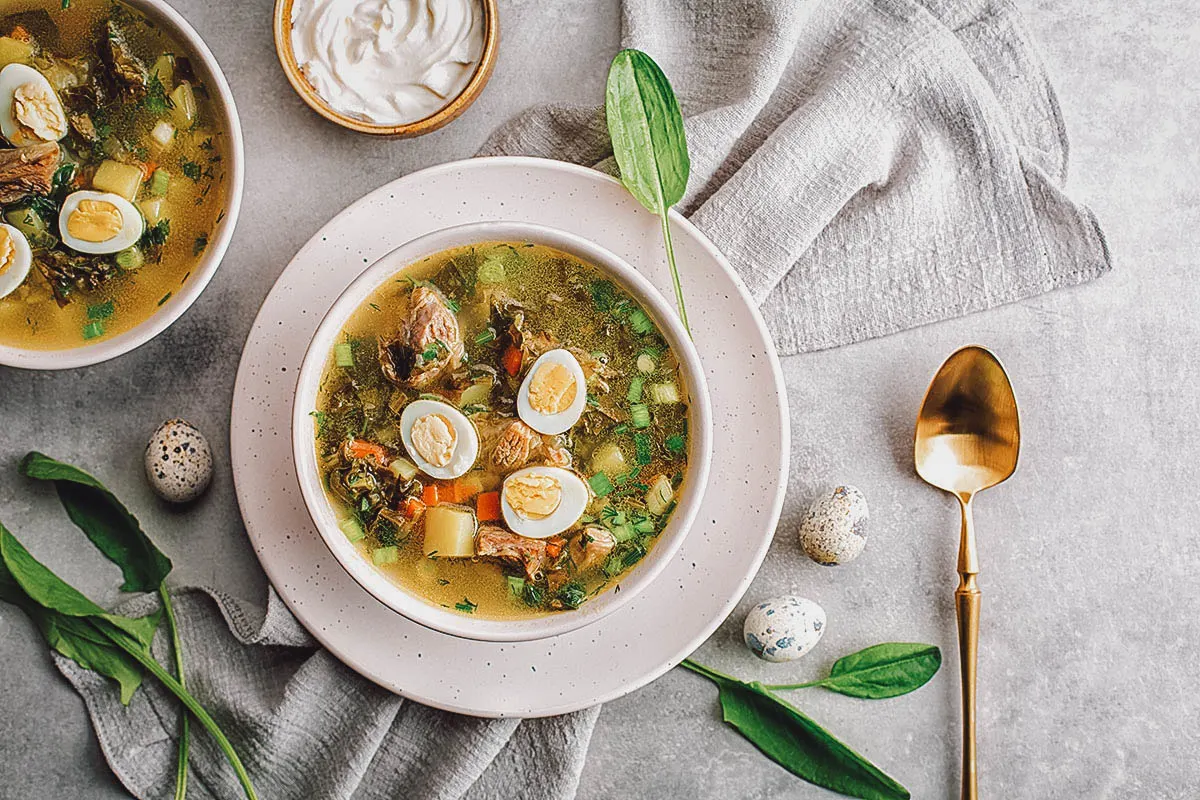
Photo by OlgaBombologna
5. Solyanka
After a night of partying and drinking horilka in Kyiv, nothing will silence that pounding headache better than a bowl of solyanka. Touted as a hangover cure, it refers to a Russian meat soup that’s also popular in the cuisines of Ukraine, Germany, and former Soviet states.
Traditionally, solyanka is made with different types of meat like beef, ham, bacon, sausage, and chicken, but seafood and vegetarian versions are common as well. Pickled cucumbers are simmered in chicken broth before being mixed together with the proteins and other ingredients like tomatoes, onions, olives, carrots, capers, and pickle juice.
The large amount of pickle juice that goes into a typical solyanka recipe is what makes it an effective hangover cure. Like borscht, it’s often served with sour cream, dill, and lemon wedges.
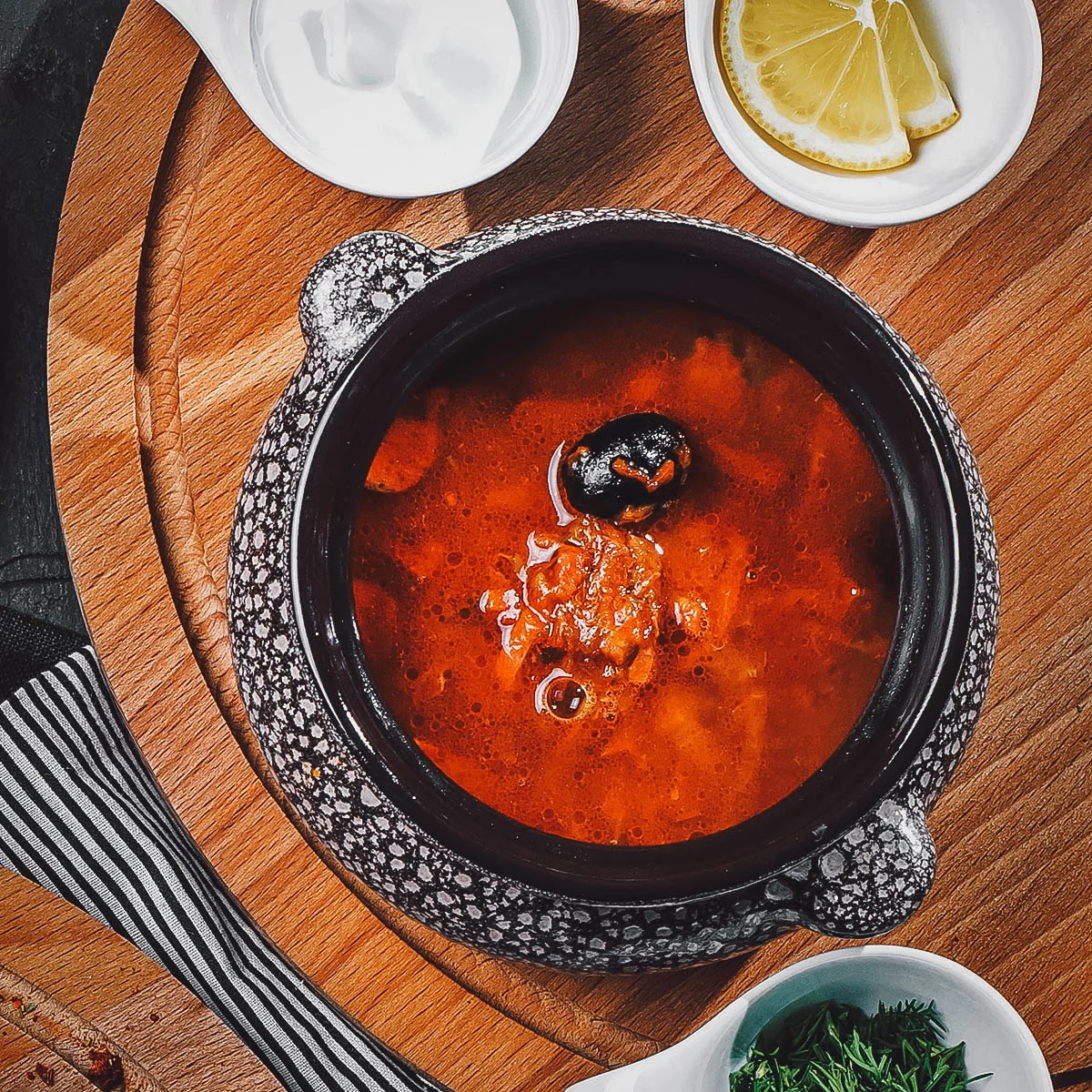
Photo by paulzhuk
6. Okroshka
If you have a taste for cold soups, then you’ll probably enjoy okroshka. It’s a traditional soup of Russian origin made with mostly raw vegetables like cucumber, radish, and spring onion mixed with kvas, boiled potatoes, eggs, sour cream, and dill. It’s often made with some type of meat as well like ham, sausage, beef, or veal.
Okroshka is fairly easy to prepare. The various ingredients are finely chopped and then mixed with kvas, which is a type of sour beverage made from fermented rye bread. It’s a common ingredient used in many cold Russian soups. Okroshka is traditionally made with kvas but other types of fermented liquid like kefir can be used as well.
Popular in summer, okroshka is always served chilled, sometimes with ice cubes added in to keep it cold during hot weather.
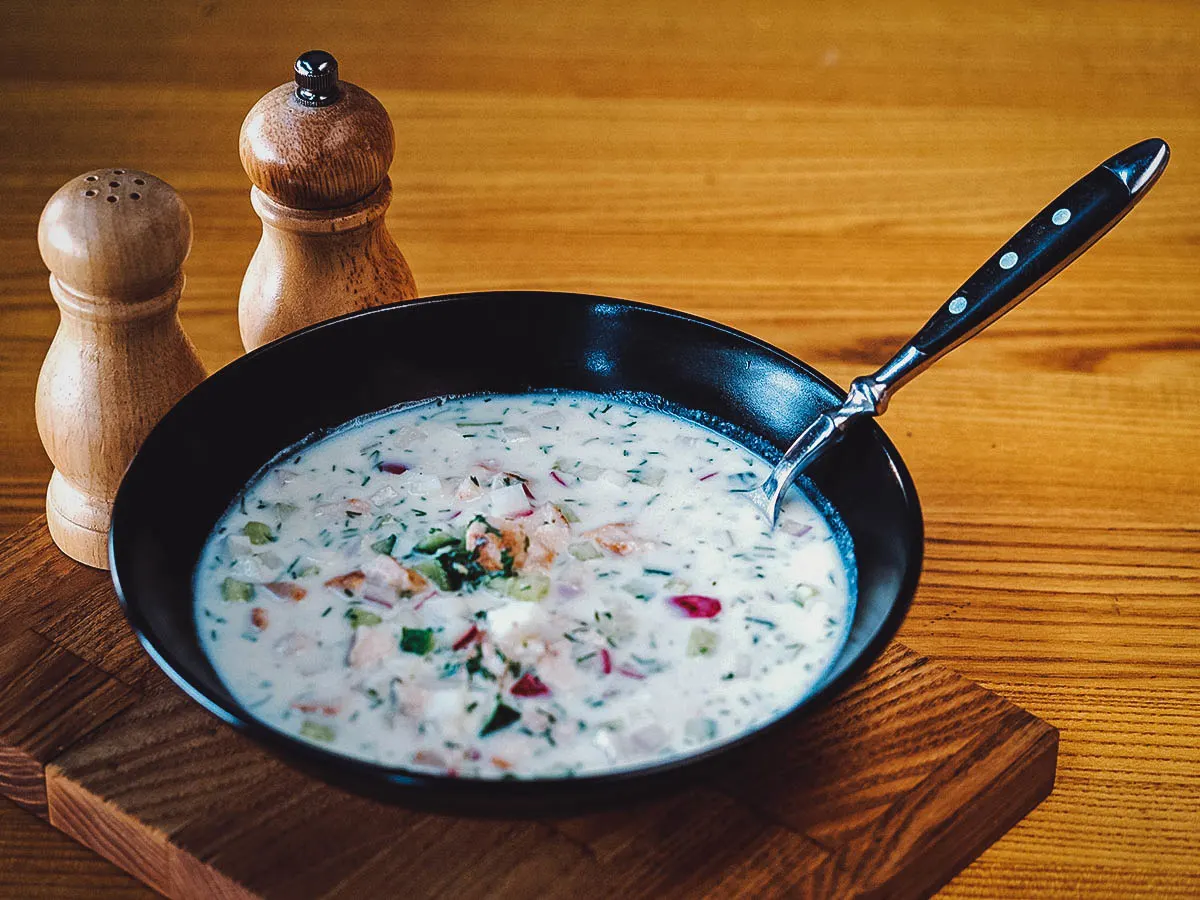
Photo by igorgolovniov
7. Guliash
Guliash refers to the Ukrainian version of goulash, a meat and vegetable stew seasoned with paprika and other spices. It’s originally an Hungarian dish that’s become popular in the cuisines of many countries throughout Central Europe.
Recipes vary but Ukrainian guliash is typically made with cubes of beef browned in oil or lard with onions, garlic, paprika, and seasonings. Water is poured in and the mixture is left to simmer until the beef becomes nice and tender. Depending on the cook, other ingredients like soup vegetables and spices may be added as well.
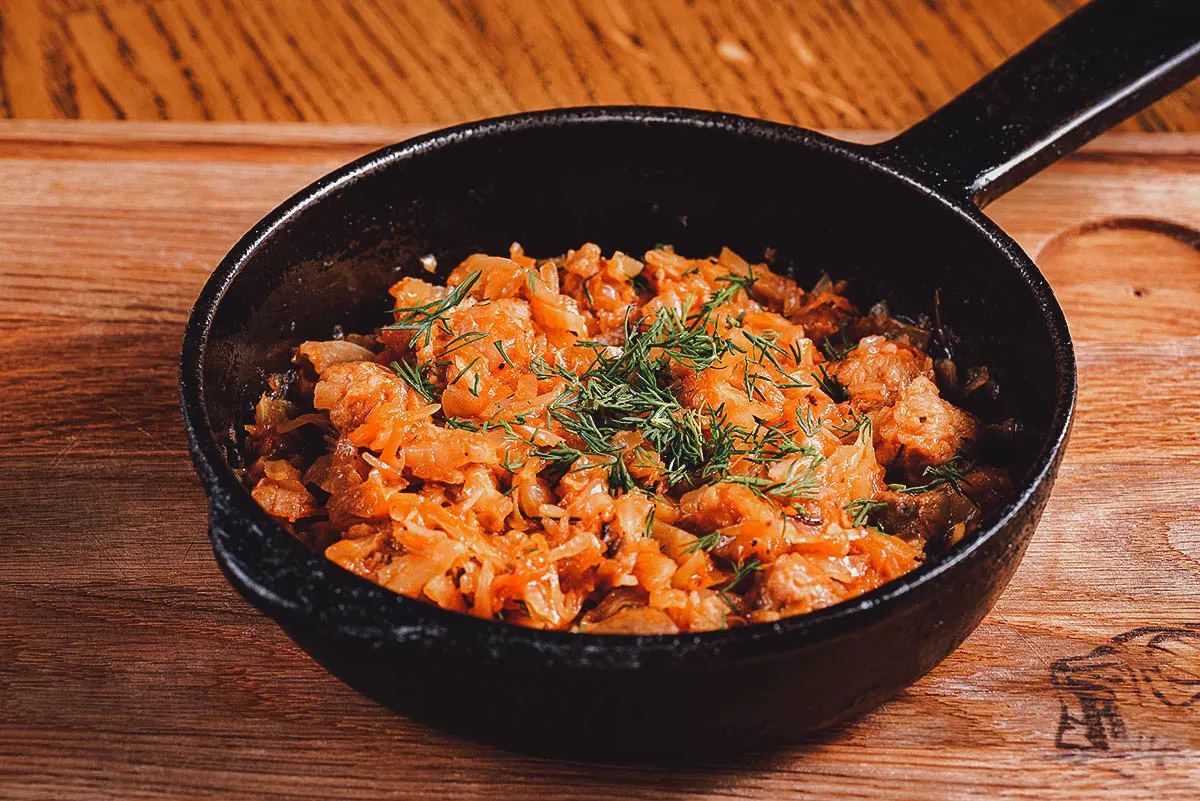
Photo by Smile.Studio
BREAD
8. Pampushka
With so many delicious soups featured in this Ukrainian food guide, it’s only fair that we showcase equally tasty breads to pair them with.
Pampushky are small yeast-raised Ukrainian buns or doughnuts made with wheat, rye, or buckwheat flour. They can be savory or sweet, baked or fried.
Savory pampushky are usually topped with garlic oil and served as a side dish with salo and borscht. You can think of them as the Ukrainian version of garlic bread. They aren’t made with a filling unlike sweet pampushky which are dusted with powdered sugar and stuffed with various ingredients like fruits, berries, jam, and povydlo (plum spread).
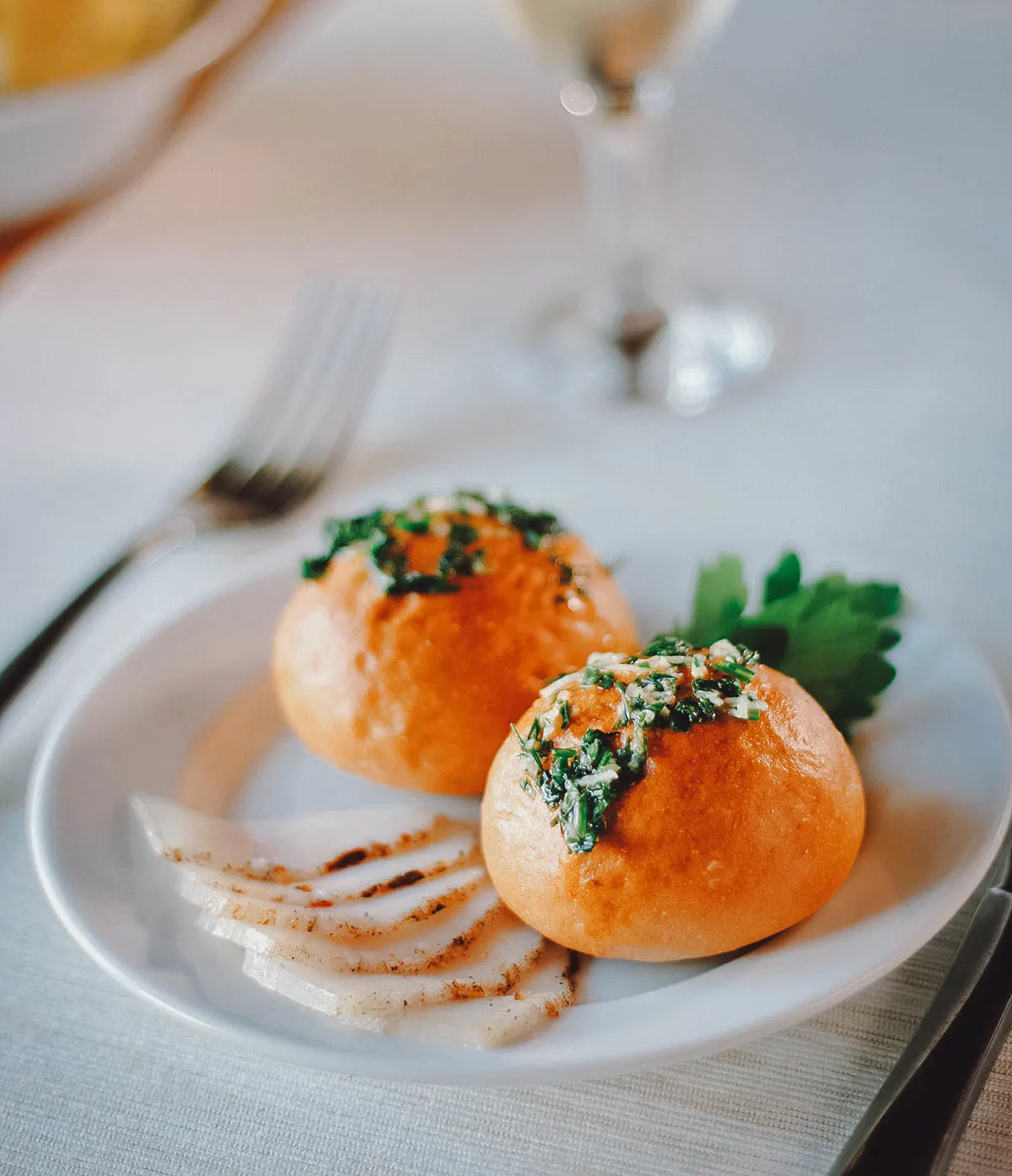
Photo by sharafmaksumov
9. Bublik
Bublik refers to a traditional Eastern European bread roll popular in the cuisines of Ukraine, Russia (baranka), Belarus (abaranak), Lithuania (baronkos), and Poland (obwarzanek). Similar to a bagel, it’s made with yeast-leavened wheat dough that’s shaped into a ring and then poached briefly in water before baking.
Bubliki are generally larger than bagels with a denser and chewier texture. But unlike bagels, they aren’t typically viewed as breakfast food. Instead, they’re eaten more as a snack or as an accompaniment to tea or coffee.
Bublik can be savory or more sweet and infused with ingredients like poppy seeds, sesame seeds, grated cheese, and onion juice. They can be enjoyed as is, dipped in tea, or paired with jam, sour cream, and other dips.
It’s believed that bubliki were invented by the Jewish population in czarist Russia but derived its present form in Ukraine. Hanging on strings by the dozen, they were originally sold as a type of street food in Ukraine.
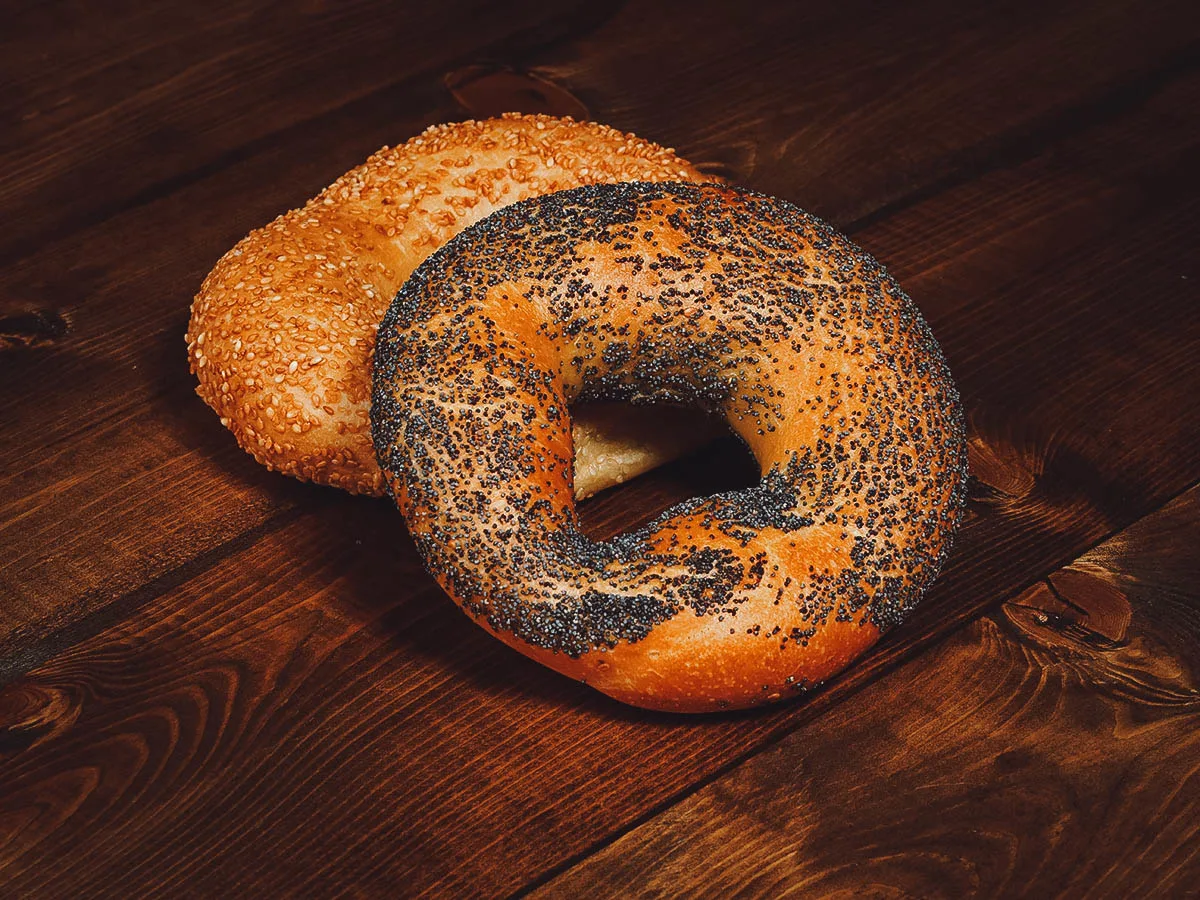
Photo by SVP064
10. Korovai
If someone asks if you’d like to attend a wedding in Ukraine, just say “I do”. It’s probably one of the few chances you’ll get to try korovai, an elaborately decorated type of bread that plays a vital role in the wedding traditions of Ukraine, Russia, Poland, Bulgaria, and Romania.
Korovai (or karavai, kravai) refers to wedding bread. Baked in lieu of a cake, it dates back to ancient times and was gifted to the bride and groom before their wedding as a blessing. It’s traditionally baked from wheat flour and embellished with symbolic elements like birds, animals, pine cones, the sun, and the moon.
As you can probably tell just from looking at it, it takes a village to make korovai. It’s steeped in tradition and is usually prepared in the home of the bride by married women called korovainytsi or breadmakers. They were typically invited in odd numbers, usually seven from seven different places, and were encouraged to sing folkloric songs to guide them through the breadmaking process. No widows were invited out of fear that their fate would be passed on to the couple.
Designs vary but certain embellishments carry symbolic meanings. The loaf’s two main birds (made out of dough) for example, symbolize the couple while the other birds represent family and friends. Flowers symbolize beauty, grapes represent wealth, and a periwinkle wreath celebrates the intertwining of their families.
Once the design is complete, the korovai is blessed before being placed in the oven by a happily married man. A cracked or malformed korovai is considered ominous while a well-risen bread is a sign of a prosperous marriage.
So important is korovai to the Ukrainian wedding tradition that it can even take the place of a ceremony! In times of hardship, when a wedding wasn’t possible, the blessing and sharing of korovai was often enough to constitute a marriage in the eyes of the community.
During the wedding, the korovai is prominently displayed close to the altar. Everyone gets a slice but the top part of the loaf symbolizes the moon and is reserved for the bride and groom. In a humorous twist, couples are known to break off a piece of bread and whoever comes away with the bigger piece is predicted to be the head of the household.
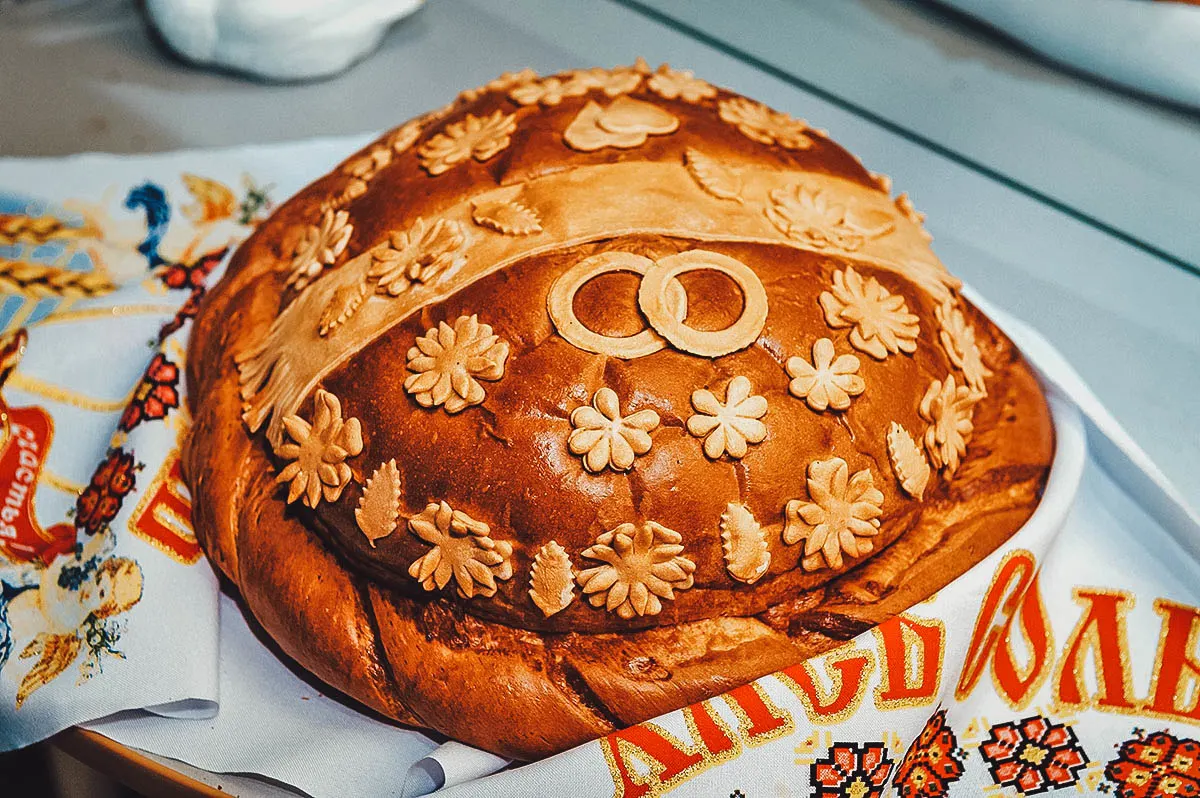
Photo by AZZ
11. Paska
Paska refers to a traditional Ukrainian Easter bread. It literally means “Easter” and is consumed in many Eastern European countries like Ukraine, Armenia, Romania, Russia, Georgia, Belarus, and Moldova. It’s a common tradition in countries with a predominantly Eastern Orthodox religion or cultural ties to the ancient Byzantine Empire.
Paska can be prepared in many ways and take different forms, but it’s typically made with eggs, butter, flour, milk, and sugar. Depending on the baker, it can contain other ingredients as well like raisins, candied fruit, cherries, vanilla, and saffron. Like korovai, paska can be decorated with religious symbols and is often topped with an egg white glaze, poppy seeds, and/or candy sprinkles.
In Ukraine, Easter baskets are traditionally filled on Holy Saturday with paska, Easter eggs, kovbasa (Ukrainian sausage), butter, salt, and other ceremonial Ukrainian foods. The food is blessed the following morning on Easter Sunday and then taken home to be shared among family.

Photo by lofoto
PANCAKES
12. Mlyntsi
Are you familiar with blinis? They refer to thin Russian-style leavened pancakes made from wheat or buckwheat flour. These pancakes are equally popular in Ukraine where they’re known as mlyntsi.
Mlyntsi are a hugely popular Ukrainian dish that’s been enjoyed since pre-Christian times. Like Russian blini, they’re commonly served with savory ingredients like sour cream or caviar but they can be enjoyed as a dessert as well, usually with sweet cream and fruit preserves.
Depending on what they’re paired with, mlyntsi can be enjoyed at any time of the day – for breakfast, as an appetizer or main course, or for dessert. They can be filled with a variety of savory and sweet ingredients like cottage cheese, stewed cabbage, mushrooms, hard-boiled eggs, fruits, and berries. Stuffed versions of mlyntsi are known as nalysnyky.
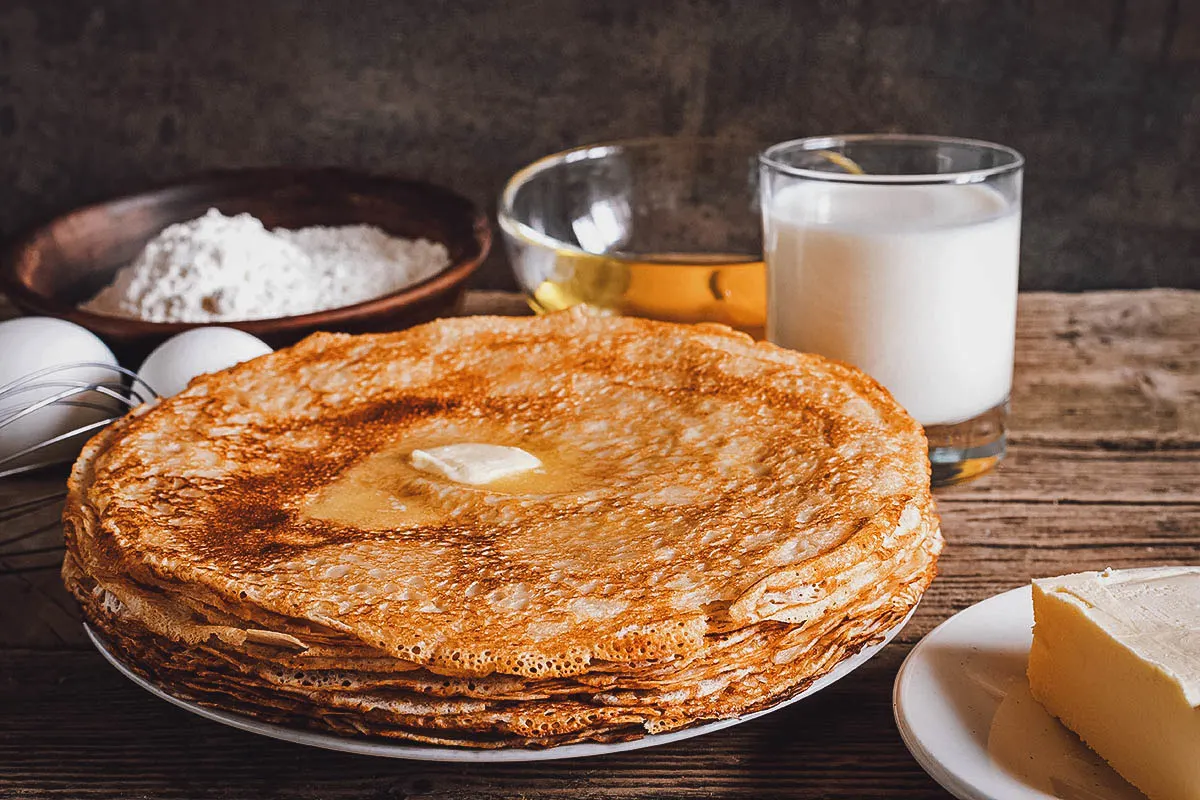
Photo by samael334.gmail.com
As described, nalysnyky refers to a stuffed version of mlyntsi. They can be rolled into tubes or folded into rectangles or triangles and filled with any number of ingredients. One of the most popular versions of nalysynky in Ukraine is filled with cottage cheese and served with sour cream.
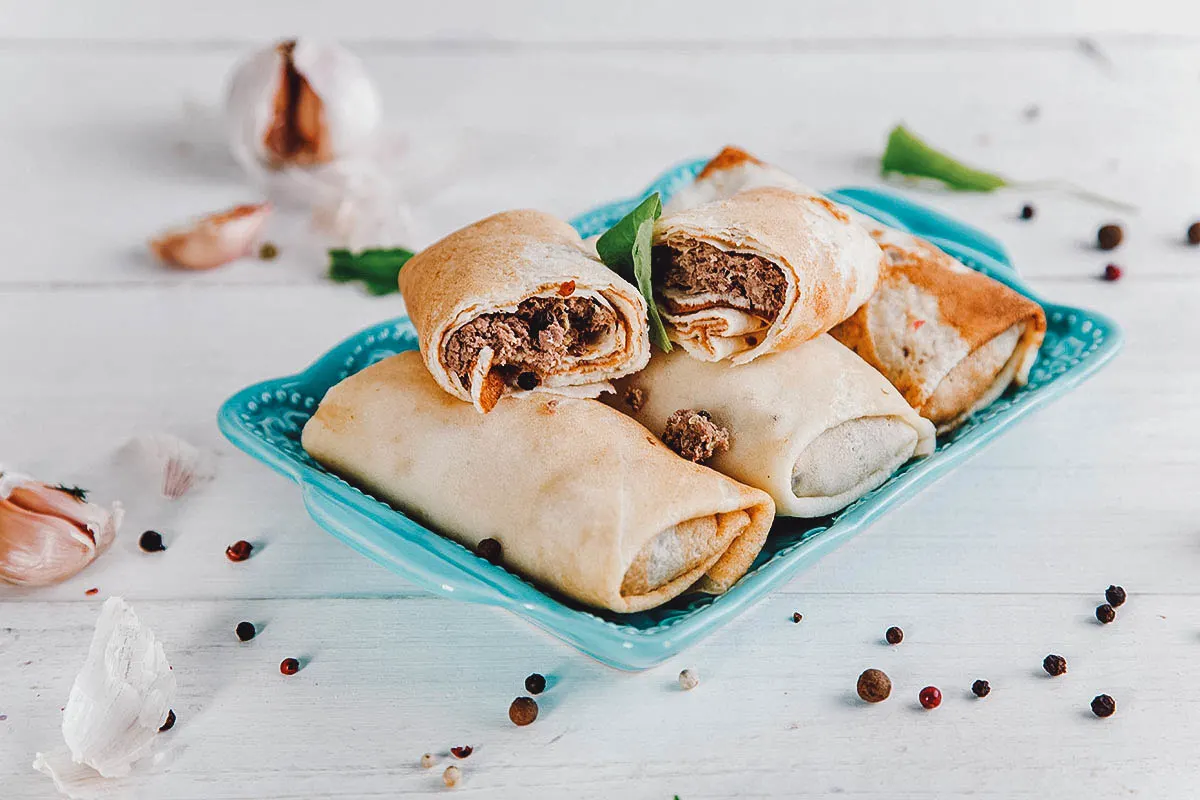
Photo by samael334.gmail.com
13. Syrniki
Syrniki refer to fried pancakes made with quark (curd cheese). They’re popular in the cuisines of many Eastern European countries like Ukraine, Russia, Belarus, Latvia, and Serbia. The name syrniki is derived from the Slavic word syr, meaning “curd cheese”.
Syrniki are made with soft curd cheese mixed with flour, eggs, and sugar. Sometimes, other ingredients like raisins and chopped fruit are added to the batter. The mixture is then molded into patties and pan-fried in vegetable oil or butter until both sides are lightly browned.
Syrniki are traditionally sweet and eaten for breakfast or dessert, but they can be made into a savory dish as well. They’re often dusted with powdered sugar and served with jam, fruit preserves, sour cream, or melted butter.

Photo by sonyakamoz
14. Deruny
Fried potato pancakes are common in many cuisines and Ukrainian food is no exception. Similar to Russian draniki or Jewish latkes, deruny refers to the Ukrainian version of potato pancakes made with finely grated potatoes, onions, eggs, flour, and sour cream.
To prepare, potatoes and onions are grated and mixed with flour, eggs, sour cream, and seasonings. Depending on the cook, other ingredients like ground meat, cabbage, and mushrooms may be added as well. Spoonfuls of the batter are then fried in a skillet until both sides turn a nice golden brown.
Like many of the dishes in this Ukrainian food guide, deruny are often enjoyed with a dollop of sour cream, either for breakfast or as an appetizer or side dish.
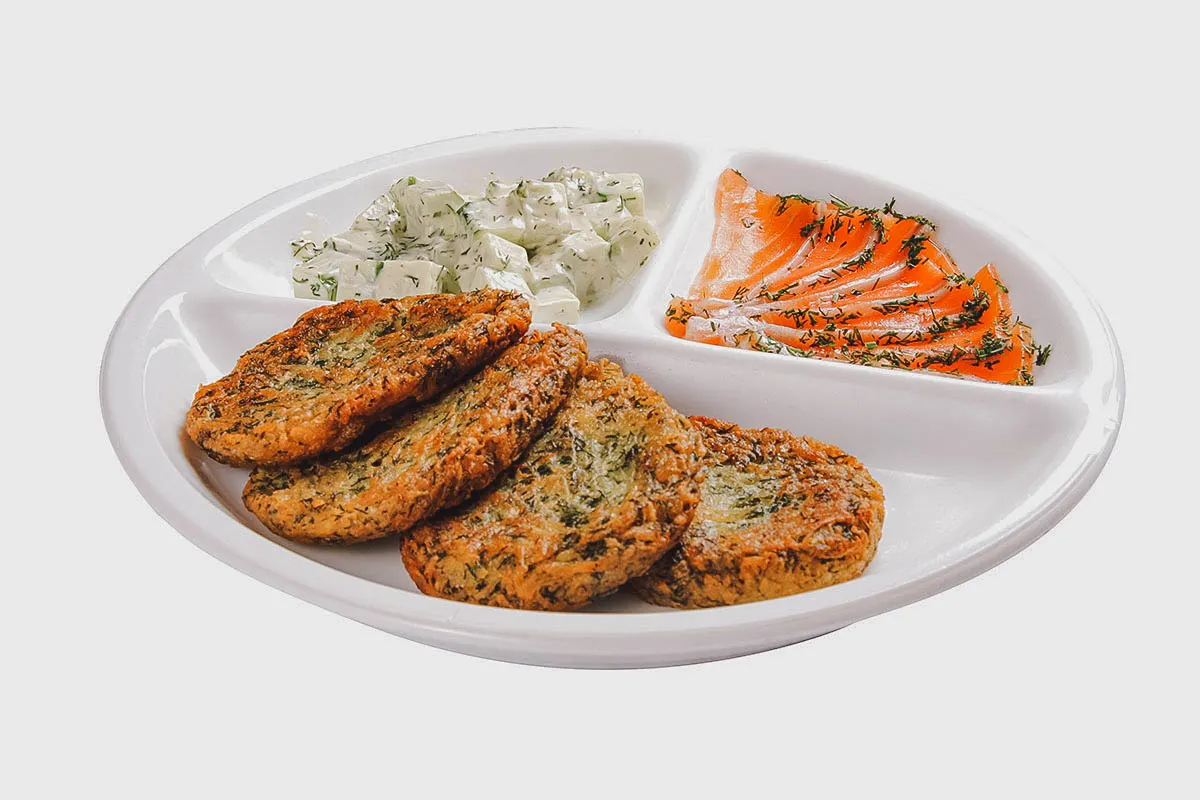
Photo by grumjum
MEAT
15. Salo
Salo refers to cured slabs of pork fatback. It’s an unctuous but popular dish consumed in many European countries like Russia, Hungary, Czechia, Lithuania, Bosnia and Herzegovina, Poland, and Slovakia. It’s especially popular in Ukraine where it enjoys cult-like status and is considered by many to be a national dish.
Salo can be made with or without skin and typically contains little to no fat. Methods vary from country to country and cook to cook, but salo is typically prepared by curing slabs of fat in salt and different spices and herbs like paprika, bay leaves, garlic, coriander, and black peppercorns. In some cultures, it can also be smoked and aged.
Salo can be eaten raw or cooked (salted, boiled, smoked, fried) and makes a great accompaniment to rye bread and horilka. It’s also used as an ingredient to make dozens of Ukrainian dishes like borscht, forshmak (salo with garlic), varenyky, deruny, and kruchenyky (meat rolls).
So deep is the Ukrainian love for salo that two festivals are held in its honor every year. The Salo Festival is celebrated in Poltava every February while a second festival called “With Love to Salo” is held in Lutsk every September.
The latter festival claims to be responsible for setting four salo world records – the biggest salo sandwich, the fastest salo consumption, the biggest salo football, and world’s the first ever “pig and salo monument”, whatever that may be.
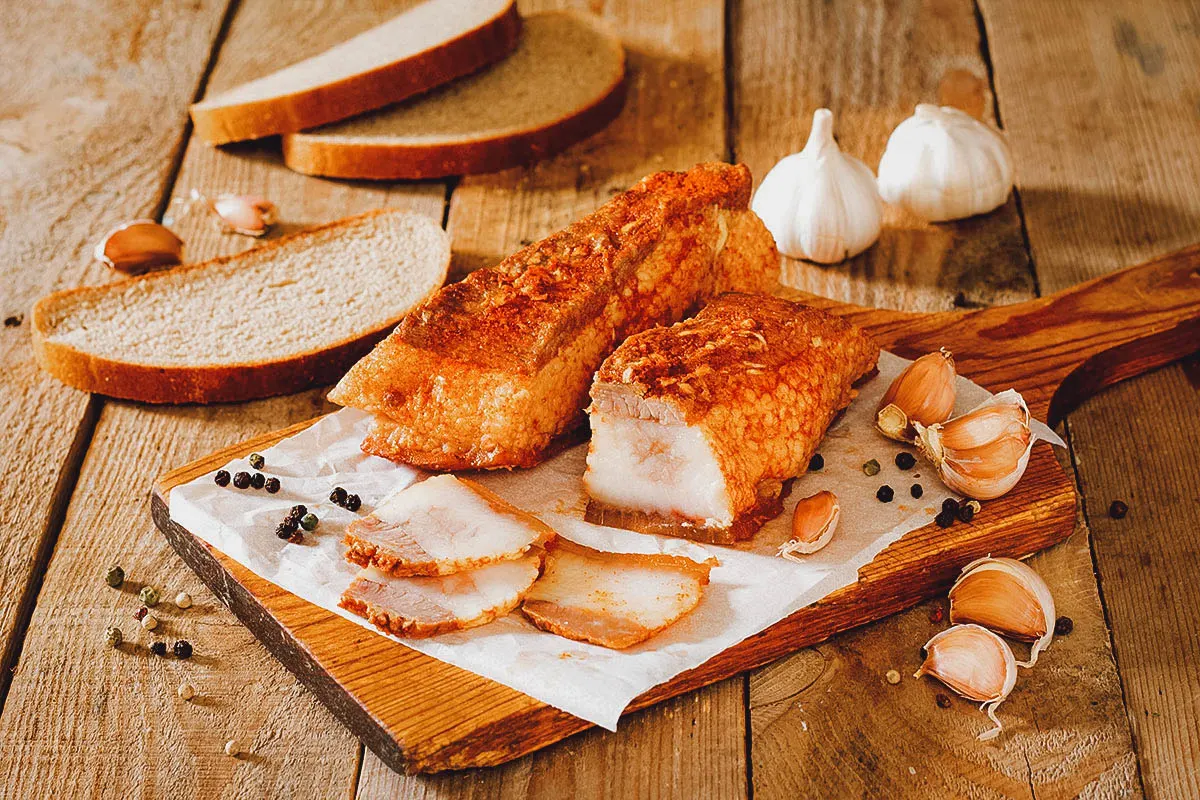
Photo by elena.hramova
16. Holubtsi
Holubtsi refers to the Ukrainian equivalent of sarma or stuffed cabbage rolls. It’s a hugely popular dish consumed in many countries throughout the Balkans, Central Europe, the South Caucasus, and the Middle East. Recipes for cabbage rolls vary but they typically consist of pickled cabbage leaves wrapped around a variety of meat or vegetarian fillings.
In Ukraine, the preparation for holubtsi varies throughout the country. A filling made with corn grits is used in some regions while buckwheat groats are preferred in others. The cereals are lightly cooked and combined with other ingredients like minced meat, pork cracklings, fried onions, and spices before being wrapped in the cabbage leaves.
Depending on the season, cabbage leaves can be replaced with fresh beetroot leaves or young grape leaves. They can be made into different sizes and shapes and stewed in a variety of sauces and broths.
Regardless of where they’re from or how they’re made, holubtsi are a beloved dish and considered an everyday type of food in Ukraine.
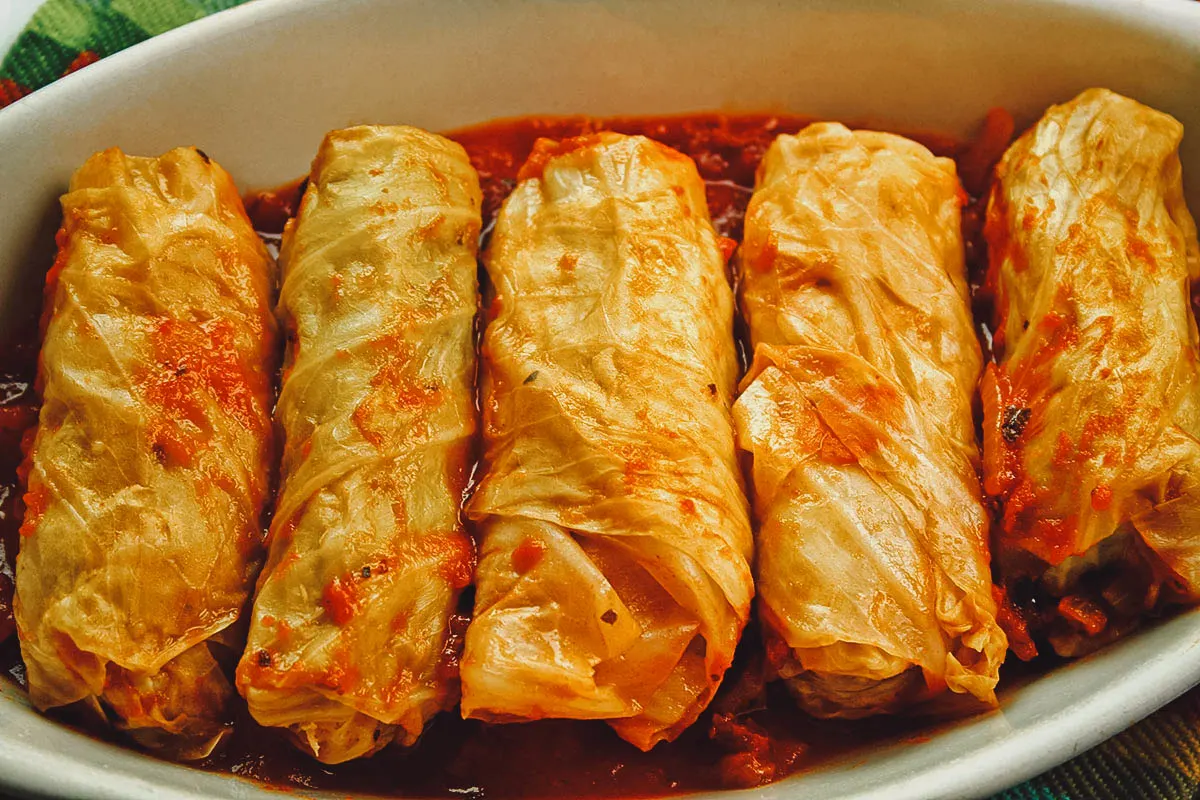
Photo by jabiru
17. Kotleta Po-Kyivsky
Kotleta po-kyivsky may not ring a bell for many people, but perhaps you’ll recognize it by its English name – chicken kiev. Named after the Ukrainian capital, it’s a popular dish in Russian and Ukrainian cuisines and has become well-known in many English-speaking countries as well.
Chicken kiev consists of a pounded chicken breast stuffed with cold herb-infused butter. It’s coated in flour, eggs, and breadcrumbs before being deep-fried or baked. It’s commonly served with vegetables and potatoes and is known for its filling of melted butter that oozes out when you slice into the football-shaped chicken meat.
These days, chicken kiev is stuffed with cold herbed butter but early versions of the dish were filled with a more complex stuffing similar to a quenelle. Classical versions of the dish were also made with the bone still attached, unlike modern versions which are more commonly made with boneless chicken fillets.
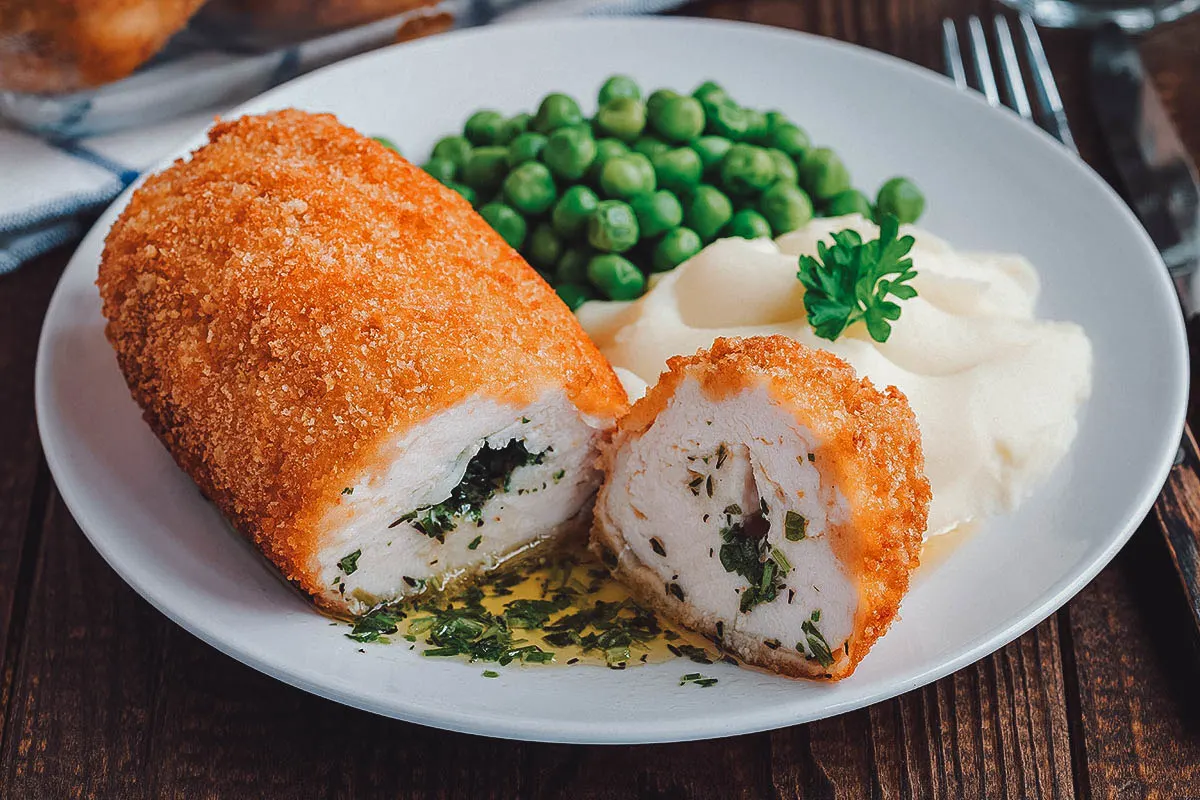
Photo by iuliia_n
DESSERTS / DRINKS
18. Lviv Syrnyk
If you have a keen interest in history and culture, then you need to make a stop in Lviv. It’s the largest city in western Ukraine and one the country’s main cultural centers. Aside from its gorgeous architecture, the city is famous for its coffee, chocolate, beer, and this delicious dessert known as Lviv syrnyk. Syrnyk in Ukrainian means “cheesecake”.
Lviv syrnyk is the most popular dessert in western Ukraine. It refers to a type of Ukrainian cheesecake made with eggs, vanilla, lemon zest, sugar, and a high fat content cottage cheese (or farmer’s cheese). Glazed with chocolate and often topped with nuts or berries, lviv syrnyk is known for its light, fluffy, and silky smooth texture that’s reminiscent of Japanese-style cheesecake.
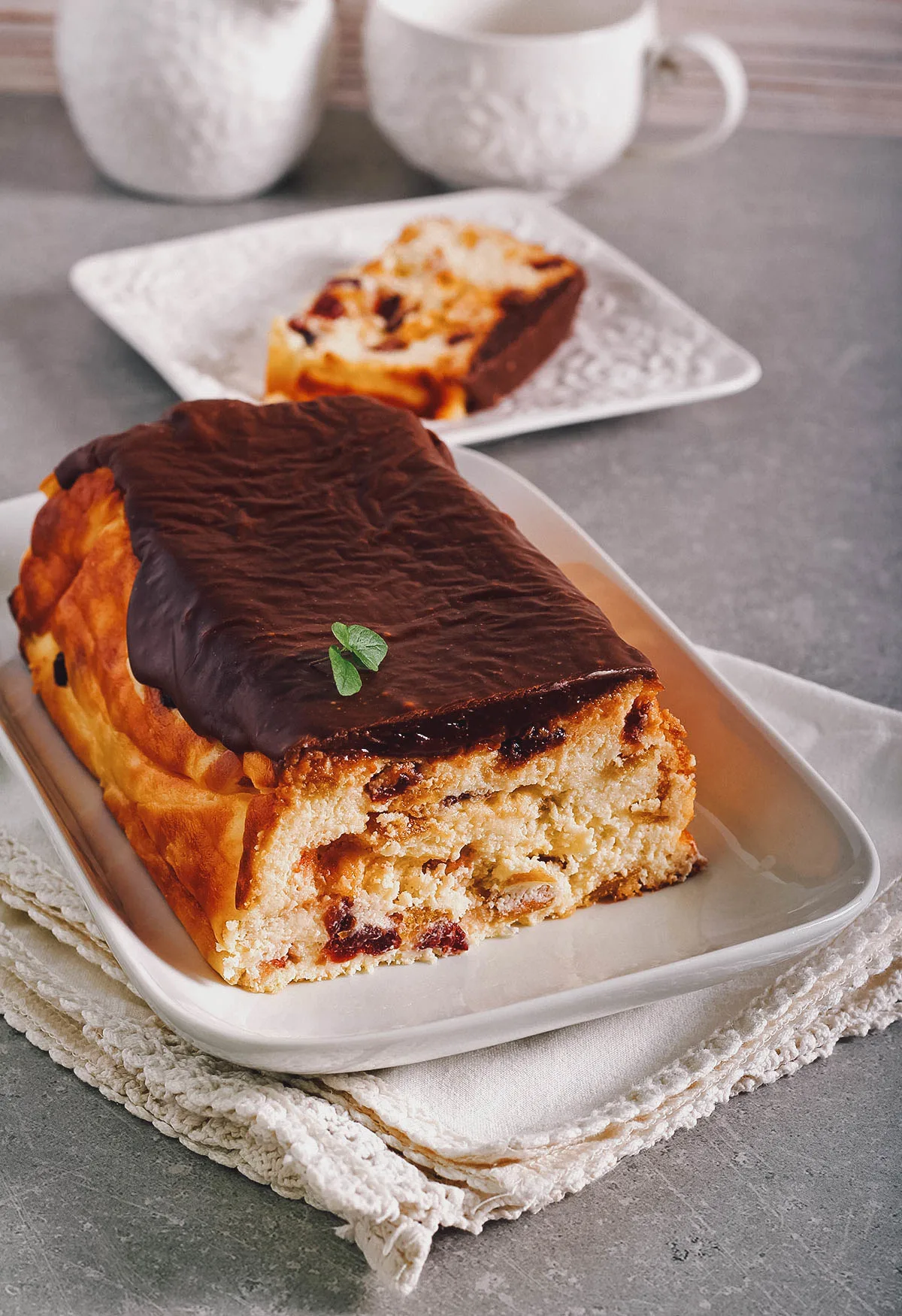
Photo by manyakotic
19. Ryazhenka
Ryazhenka refers to a type of fermented milk product popular in Ukraine and Russia. It’s made by simmering pasteurized milk on low heat for at least eight hours until it thickens and achieves a pale caramel brown color. Sour cream is then added to ferment the milk before it’s consumed, usually for breakfast or with cake and biscuits as a snack.

Photo by dolphy_tv
20. Horilka
If you’re a fan of Moscow mules or screwdrivers, then you’ll definitely enjoy horilka, the Ukrainian equivalent to vodka. Derived from the Ukrainian word hority meaning “to burn”, it refers to a family of vodka-like spirits distilled from wheat or rye.
Horilka is traditionally made from grains but it can be distilled from other ingredients like potatoes, honey, and sugar beets as well. It contains about 40% alcohol and exists in many varieties, one of the most popular being pertsivka which is a type of horilka infused with chili peppers.
Pertsivka is one of the most well-known but horilka can be flavored with a multitude of ingredients like berries, plums, rose hips, apricots, nuts, and citrus fruits. It’s typically enjoyed in small shots and takes center stage in traditional Ukrainian weddings and feasts.
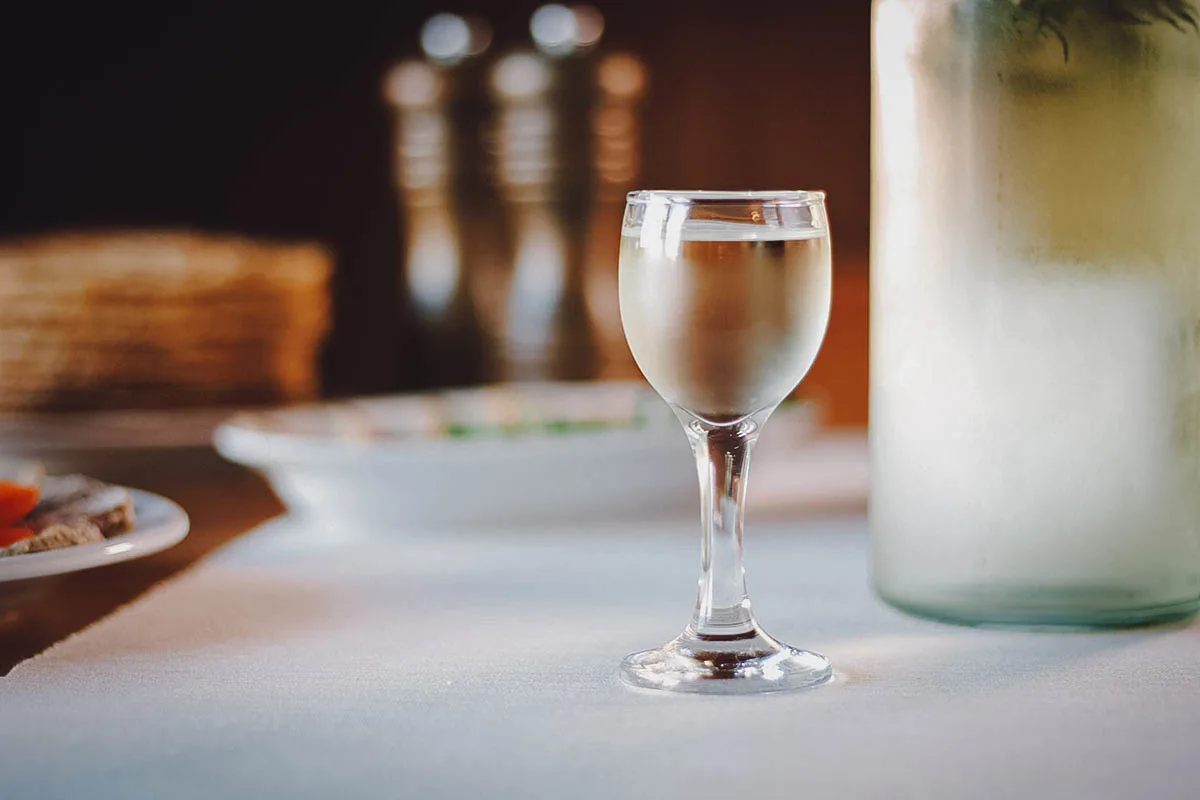
Photo by sharafmaksumov
UKRAINIAN FOOD TOURS
We love exploring the local cuisine on our own, but no one knows Ukrainian food better than a local. What better way to experience the best of Ukrainian cuisine than by going on a food tour?
A knowledgeable guide will take you to the city’s best restaurants and markets so all you have to do is follow and eat. Check out Get Your Guide for a list of Ukrainian food tours in Kyiv, Odessa, Lviv, and other cities throughout the country.
FINAL THOUGHTS ON UKRAINIAN FOOD
Ukraine is the second largest country in Europe yet it continues to be one of its most underrated.
Kyiv and Lviv are historic cities with centuries-old architecture while Odessa is a popular summer destination on the shores of the Black Sea. This laid back port city is also home to an international film festival that draws in tens of thousands of visitors every year.
And we can’t forget about Chernobyl, site of one of the worst nuclear disasters in human history. Just 90 km (56 mi) north of Kyiv, travelers with a taste for dark tourism can visit the power plant to see the effects of the tragedy first-hand.
Clearly, people looking for the road less traveled will have much to see and do in Ukraine. And as outlined in this Ukrainian food guide, they’ll have plenty of interesting dishes to eat as well.
Disclosure
Some of the links in this Ukrainian food guide are affiliate links. If you make a booking, then we’ll earn a small commission at no additional cost to you. As always, we only recommend products and services that we use ourselves and firmly believe in. We really appreciate your support as it helps us make more of these free travel and food guides. Thank you!
Cover photo by urban_light. Stock images via Depositphotos.


Katherine
Saturday 31st of December 2022
I would strongly recommend taking down the mentioning of the olivye salad on this page. Simply because this page is dedicated to traditional Ukrainian dishes... and this is a famous Russian dish with a direct Russian association more so than the other recipes here- or Soviet, if you prefer to call it that.. just as equally undesirable for Ukrainians to be compared to today.. (I see you defending yourself in comments below about it being "Soviet," but don't know if the Holodomor rings any bells for you, for example...). It may come off as very insulting for actual Ukrainians to see this page (my Ukrainian husband is especially irritated for you to have included it on a page that is meant to celebrate Ukrainian dishes). It's true, this has been an especially popular New Year's dish to make here in Ukraine, but with the current world events happening.. many are refraining from making this specific dish this year and are opting for different salads to welcome the new year. Perhaps you can replace it with something actually Ukrainian? I doubt you won't get much backlash about it since you cater to a western English-speaking audience only, but I still feel it's really important to educate as much as possible, and this would be a good step in the right direction to honor Ukrainians, especially during times like these. Wishing you a happy new year
Vlad
Saturday 29th of October 2022
Nearly all if not 100% of these dishes are equally Russian and Belarusian. Not sure why it was not mentioned in this article.
Natalie
Thursday 1st of December 2022
@Vlad, ?!? Practically every dish is described as being “of Russian origin”. Which is questionable.
Missing are Vinihret - salad with beets potatoes pickles and beans. Kholodets - meat in aspic. Kotlety - meat balls. Half sour tomatoes and pickles. These are more important in Ukrainian cuisine than “Olivier” which is Soviet.
Sil
Saturday 16th of April 2022
If you're doing an article on Ukrainian food then it should be an article on Ukrainian food. I don't know why you did not call this article Russian food? Learn how to write and learn how to edit. Very important facts in journalism.
JB & Renée
Saturday 16th of April 2022
Hi Sil, thanks for expressing your opinion. I didn't call this article "Russian food" because it's about Ukrainian dishes. Though some of them may have originated elsewhere, they've been consumed long enough in Ukraine to be considered Ukrainian food.
The fact is, the origins of food are often blurred because of a multitude of reasons like migration or conquest. Just look at the entire Balkan region and the Caucasus and you'll find many countries claiming ownership of the same dish. Satay is Indonesian in origin but it's now considered a Malaysian national dish. It's equally popular in Thailand and Singapore as well.
Similarly, tacos al pastor, gyros, and shawarma are all descendants of the Turkish doner kebab. But I think we can agree that they're now parts of Mexican, Greek, and Lebanese cuisines. Kibis descended from kibbeh. The empanada is originally from the Iberian Peninsula but it's now very much a part of Latin American and Filipino cuisines. Same goes for the Indian samosa. I don't think anyone can deny that it's Indian food though evidence suggests that it originated from the 10th century Middle East. Food migrates, transforms, and is absorbed into other cultures which is part of what makes it so fascinating.
And for the record, I have a degree in English Literature from Georgetown University. I do know how to write and edit. I appreciate your opinion but next time, try to express it without being condescending or rude. Have a good day.
Lilly F.
Thursday 10th of March 2022
Thank you for such a thorough menu palette of authentic Ukrainian foods and how they are prepared and served. As an American Ukrainian, I was raised on many of these kinds of foods, can make some of them even today. Just reading about them and seeing authentic photos were reminiscent of the rearing of my Ukrainian childhood family....especially at Christmas and Easter. Thank you. LF
JB & Renée
Wednesday 16th of March 2022
Really happy to hear that you appreciated the post Lilly and it brought back many fond memories for you. So heartbreaking to see what's going on right now. Praying for a swift and favorable end to this madness. Our hearts and prayers go out to the people of Ukraine.
Erika
Wednesday 29th of December 2021
A lot of this information is dated and inaccurate. Borsch truly is a red soup. It also has beets. But tomatoes make the soup red. Beets are usually of a similar amount as the other vegetables, not the primary ingredient. Also, why include so many Soviet and holiday specific dishes, but leave out other Ukrainian dishes such as sausages, banosh and uzvar (among others!)?
JMH
Friday 28th of October 2022
@Rta, I learned how to make beet kvass specifically for the purpose of making authentic borscht. Well worth the wait and a very intense Ruby red color. The only problem that I have with beet kvass that I drink it all before making the borscht because I love the flavor. Borscht without beet kvass is not authentic borscht. It’s like ketchup that’s made with vinegar instead of fermentation. Not the real deal.
Rta
Monday 6th of June 2022
@Erika, I disagree. Borshch is red due to the addition of beetroots. Tomatoes became a common addition to Borshch as a substitute to beet kvas. Beet kvas was what gave borshch its sour taste, but it took a few days to prepare it. When you want to make borshch quickly, it's easier to substitute the beet kvas with something that is cheap and sour, but there were no alternatives like that until the tomatoes arrived to Europe. Nowadays, tomato paste has turned into an essential ingredient for borshch. Only some tomato paste is added, which is not enough to brightly color the whole soup. Beetroot, on the other hand, gives a very deep red color, which is typical for a red borshch. In a real borshch, beetroot and cabbage make up the majority of the vegetables, so beetroot IS one of the primary ingredients. Also, I see only one Soviet dish here (the modern version of the Olivier Salad). Indeed there are a lot of common East Slavic dishes on the list, but they originated way before the Soviet Union formed.
JB & Renée
Thursday 30th of December 2021
Thanks for letting us know Erika. We'll do better on the next article update.